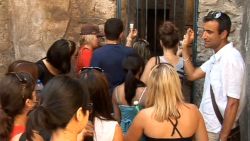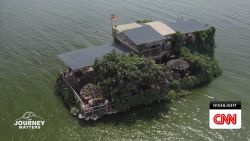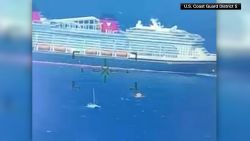Editor’s Note: CNN Travel’s series often carries sponsorship originating from the countries and regions we profile. However, CNN retains full editorial control over all of its reports. Read the policy.
It’s considered one of the world’s most dangerous active volcanoes. Just 55 kilometers south of Manila, Philippines Taal Volcano has erupted 30 times since the 16th century, accounting for the deaths of more than 5,000 people.
Yet it’s scaled daily by dozens of groups of laid-back tourists.
Perhaps they’re calmed by Taal’s reputation as the smallest active volcano in the world – it’s just 311 meters tall – a title that hints at peril yet makes Taal sound relatively unintimidating. Or maybe it’s the fact that after eight eruptions in the 1960s and 1970s, Taal Volcano has not vented its fury since 1977. It’s also in an incredible location that defies belief.
Taal Volcano sits on an island within a lake within an island, adjacent to the holiday town of Tagaytay, a popular getaway for Manila residents.
Ready to take the risk?
After arriving in Tagaytay, the first step is to take an outrigger boat across the deep blue waters of Taal Lake to Volcano Island.
This 15-minute trip costs about $10 each way – you can hire a boat yourself or join a group tour from Tagaytay. Once visitors arrive at the main jetty on Volcano Island they can choose whether to do a 30 to 40-minute hike up its slope or complete the ascent on horseback.
A small tourism office next to the jetty offers a horse and guide for about $20 return, although there’s wiggle room if you’re a skilled barterer. Considering the high heat and humidity in Tagaytay throughout the whole year, riding a horse is an attractive option.
I picked the biggest one I could find, mounted it and headed off from the office with my young Filipino guide Anna leading the way.
Despite the rough, bumpy dirt path, which leads up to the volcano rim, it was an enchanting experience.
Photos: In the Philippines, a volcano on an island in an island
For me it was, at least. My horse clearly didn’t share my enjoyment, becoming increasingly skittish.
As other tourists overtook me on their relaxed steeds, my horse stopped to make prolonged noises of apparent anguish.
“I’m sorry but I think you’re too big,” Anna told me sheepishly.
At 197 centimeters tall and 126 kilograms in weight, I could only nod in agreement. After covering minimal ground during my five-minute horse ride, I set off on foot. Roughly half of the other tourists heading for the rim were also hiking.
The slope is relatively gentle, making it a fairly easy hike for people even with a low level of fitness. There are also ready-made excuses to take a rest if you do lose your breath. The higher you climb, the more striking the views across the island and the crystalline waters of Taal Lake.
Hiking boots or running shoes are advised – the dirt path is frequently uneven and unstable. There’s also great value in hiring a guide to ascend with you, even if you’re not riding a horse.
Anna was fine company and provided much info about Taal Volcano’s lethal history – including the fact it once erupted for more than six months, back in 1754.
A volcanic Russian doll
As I completed the final ascent to the rim I detected a pungent, chemical odor. It’s hard not to feel alarmed when experts warn that acrid fumes or strong sulfuric scents are a pre-cursor to an eruption. Then at the rim I found a couple sitting on a bench eating ice cream, while a young family giggled as they hit golf balls into the crater.
Clearly, there was no cause for concern.
The volcano is only closed to visitors on the rare occasion that Filipino authorities upgrade it from an “Alert Level 0” to an “Alert Level 1,” which means there’s no threat of imminent eruption but that the volcano is behaving abnormally.
These tourists were soaking in what, for many visitors, is the payoff of scaling the volcano – sprawling views of the crater, its lake and beyond.
In the fading afternoon light, the waters of Crater Lake appeared to gently bubble in certain areas, while other patches were stained white by sulfur. Adventurous visitors can hike around the rim. There are two trails, both about a kilometer long, which head in opposite directions around the rim.
Like the path up the mountain they’re rugged so progress is slow. These paths are also narrow, with steep drops on one side, so caution is necessary. The steam, rising from the earth near sections of these paths, provides a reminder of the volcano’s deadly power.
What these trails also offer is a closer vantage of the small, volcanic Vulcan Point Island inside Crater Lake.
Taal is like a volcano version of a Russian doll. Tiny Vulcan Point Island sits inside Crater Lake, which sits inside the Taal Volcano, which is inside Taal Lake. All are contained within Taal Caldera, a massive volcanic crater created hundreds of thousands of years ago by a gigantic eruption.
This prehistoric tectonic activity spawned a chain of volcanoes on the western side of Luzon Island, the largest of the more than 7,000 islands in the Philippines.
Taal Volcano may be the deadliest of them all. But it’s been asleep for 40 years. So now is a good time to visit.
Getting there
Buses and minivans depart downtown Manila for Tagaytay at regular intervals each day. The trip takes between 90 minutes and two hours.
From Tagaytay, catch a taxi to one of the small piers on the edge of Taal Lake. Then negotiate with one of the outrigger boat operators to make the 5-kilometer trip across to Volcano Island. More info at Taalvolcano.org.
Ronan O’Connell is a freelance photojournalist. He’s contributed to more than 40 media outlets across the world including BBC, The Guardian, San Francisco Chronicle, Toronto Star, South China Morning Post, Irish Examiner and Australian Financial Review.



















